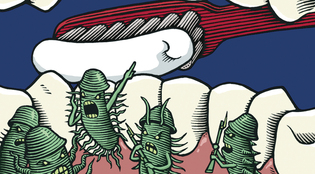 loading
loading
FindingsHow bacteria fight fluorideRamping up with riboswitches.  Gregory NemecView full image
Fluoride, long added to toothpaste and drinking water to protect against tooth decay, improves dental health significantly. But it's not a perfect defense. Why isn't it more effective? Yale researchers believe they have the answer: they've discovered the molecular weapon bacteria use to fight fluoride's effects. Fluoride hardens teeth against the acids produced by bacteria in our mouths, and at high concentrations, its toxic effects can also overwhelm the ability of bacteria to thrive. But the team found that when a bacterium senses too much fluoride within its cell wall, it flips on a section of messenger RNA called a riboswitch. These riboswitches "are detectors made specifically to see fluoride," says Ronald Breaker, professor and chair of the Department of Molecular, Cellular, and Developmental Biology and senior author of the study (which was published in the December 22 online issue of the journal Science Express). "If fluoride builds up to toxic levels for the bacteria in the cell, a fluoride riboswitch grabs the fluoride and then turns on genes that can overcome its effects." One thing is clear, says Breaker: biology has hated fluoride for a long, long time. So to defend against its toxic effects, evolution "invented an RNA riboswitch that could sense fluoride and deal with it."
The comment period has expired.
|
|